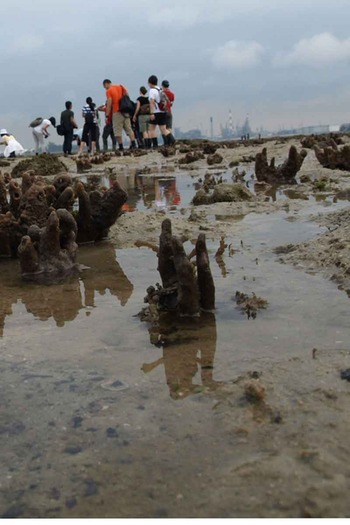Mallika Naguran reviews the recently launched Habitats in Harmony: The Story of Semakau Landfill by Marcus Ng. It was published by the National Environment Agency to commemorate 10 years of the offshore landfill’s operations that has now doubled up as a unique recreational destination for nature lovers.

Sponges stick out when water ebbs at Semakau reef flat.
Singapore, 17 September 2009. I love receiving books as gifts (except for self-help books, which I regard as an insult) and have started a collection of books on ecology, anthropology and marine species identification. My latest collection, Habitats in Harmony: The Story of Semakau Landfill by Marcus Ng, stands among the higher, more visible shelves and ranks as one of the must-read books on Singapore ecology.
It’s compulsory reading to she who has no clue of what happens to the McDonald’s burger wrapper that junked and worries about where it goes or what it does to the environment. The book also has a historical record of the old Singapore - how sleepy kampongs (villages) on the islands were relocated to make way for development.
Then there are delightful stories and pictures about birds and the bees, and more, that give an overwhelming awareness of the varied and abundant numbers of animal and plant species that exist at our doorstep. Well nearly.
The landfill - just 30km away from mainland Singapore – is situated on a site that has fused two islands, Pulau Sakeng and Pulau Semakau, into one big dumping ground. It takes the burnt waste coming from the mainland daily – about 2,000 tonnes of garbage reduced to ash – as well as waste that cannot be burnt like inert and inorganic, which has to be treated then buried. Away from sight and mind.
Surprisingly, it is not all bleak.
For this sand miraculously puts forth a green shoot that suns itself into wild grass that becomes a hiding place for migratory birds. No fertilizer or seeds are needed.
Nature is the greatest transformer, giving new life even in the most unexpected places. Like the best of women, nature picks up when knocked down. But there’s always a limit where nature finds that it cannot regenerate by itself.
This is where nurture steps in. The threat of pollution prompted safe methods in building the plant, such as a 2mm impermeable geomembrane lining the 7km perimeter rock bunds that prevents toxic seepage into the sea.
The open-sea construction and deep-sea piling must have taken its toll on the marine life, adding to the high sedimentation that’s characteristic of Singapore waters, but this is not captured anywhere in the book. Coral reefs surround the island, in particular the north, and reef flats on the west end. An intertidal walk on this reef flat gives you an idea of just how rich a community of marine creatures there is.
The government did ensure, however, that all is not destroyed during construction; it took up Professor Chou Loke Ming’s suggestion of protecting the coral reefs lining Pulau Semakau’s western shore with a fine mesh silt screen. This would stop sediments from choking the air that corals need.

Corallite maze gives this animal its name - brain coral.
Mangroves were also preserved by removing them from the construction area, and then replanting them. Fourteen hectares of mangroves were saved, thanks to biologists, Professors Leo Tan and Lee Sing Kong. The book captures the initial failed attempt to restore the Bakau Minyak (Rhizophora apiculata) on newly created land plots due to incompatible acidity, followed by successful operations in planting 400,000 saplings that now stand tall, inviting egrets, herons, hawks, sea eagles, kingfishers, plovers, butterflies, hornets and more.
Habitats in Harmony: The Story of Semakau Landfill records 279 species of resident plants, birds, insects, fish and other marine creatures. There are 52 species that are rare and threatened such as the great-billed heron, cryptic seastar, mosaic crab and two-spotted-line-blue butterfly. There are also some species in Semakau Landfill that cannot be spotted elsewhere in Singapore.
The book takes an encyclopedic approach in its description of all things big and small that can be seen, felt, heard, touched and maybe even tasted at this dumping ground (I wouldn’t recommend touching a sea anemone though or putting a red egg crab in the mouth).
I would recommend, however, a walk on this recreated land in the sea, to appreciate how nurture is an essential bedfellow to nature, to ensure that development is kept within safe limits, always. It’s an example of how conservation - being part of a building and construction master plan - is not just sensible, but essential for the harmony of habitats.
What I like about the book is that it tries to propound an understanding of the species encountered, from the scientific to behavioral descriptions and roles in the ecosystem. Plus it has meaningful photo captions!
What I really like about the book is that it tells you why and how, and not just what is. Something you wouldn’t quite expect from a typical coffee table book backed by the government.
Photos by Mallika Naguran
You can now own your copy of the commemorative book at S$24.90. The book is now available at the National Environment Agency, Customer Service Centre, Level 2 Environment Building, 40 Scotts Road and at Semakau Landfill.
http://app2.nea.gov.sg/semakaubook.aspx
For more information, please contact NEA at 1800-225 5632 or email contact_nea@nea.gov.sg
Recreational Activities on Semakau are possible only by prior appointments:
Intertidal walks – Raffles Museum of Biodiversity Research
http://rmbr.nus.edu.sg/workshop/semakau_workshop.php
Birdwatching – Nature Society (Singapore)
Stargazing – Astronomical Society of Singapore
Editor’s Note: Sport fishing on Semakau exists as an activity but is frowned upon by Gaia Discovery as it inflicts pain and suffering on fishes. Instead of sport fishing, guided nature treks, snorkeling, kayaking and swimming have less impact on the environment. More information here on fish feeling pain.